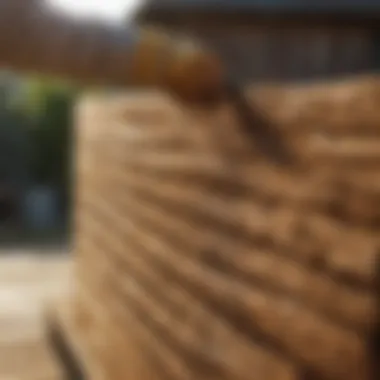Understanding Termite Wood Treatment Spray in Agriculture


Overview of the Topic
Definition and Importance
Termites present a substantial risk to wooden structures, particularly in agricultural settings where barns, silos, and other buildings often use wood as a primary material. Termite wood treatment sprays are chemical formulations designed to protect these structures from infestations. Understanding the significance of these treatments is essential for farmers and agricultural professionals. They not only help in maintaining the integrity of wooden structures but also support sustainable farming practices by safeguarding crops from being compromised by termite activity. The increasing awareness regarding environmental protection emphasizes the need for effective and responsible pest management strategies.
Current Trends
Presently, there is a growing trend towards the use of eco-friendly termite wood treatment sprays. These products are formulated to minimize harm to beneficial insects and the surrounding environment while effectively combating termite populations. More farmers are seeking solutions that align with organic farming principles. Alongside eco-friendly options, there are advances in technology that focus on monitoring and predicting termite infestations, aiding in proactive treatment application.
Key Techniques and Practices
Step-by-Step Guide
- Assessing Termite Risk: Regularly inspect wooden structures for signs of termites, such as mud tubes or damaged wood.
- Choosing the Right Spray: Select a termite wood treatment spray that suits your needs, taking into account both effectiveness and environmental impact.
- Application Process:
- Regular Maintenance: Reapply the treatment as suggested by the manufacturer, usually once a year or after heavy rain.
- Ensure the area is clean and dry.
- Apply the spray evenly on the wooden surfaces using a sprayer or brush.
- Pay extra attention to joints, cracks, and any potential entry points for termites.
- Allow the spray to dry completely before using the structure.
Tools and Equipment Needed
- Protective gear (gloves, mask, goggles) to ensure safety during application.
- A high-quality sprayer or brush for even distribution of the treatment.
- A measuring tool to assess the areas needing treatment accurately.
Challenges and Solutions
Common Obstacles
Farmers often face several challenges when dealing with termite infestations. These include limited access to certain areas for treatment, varying soil types that affect spray effectiveness, and the financial burden of continuous treatments. Moreover, there might be skepticism regarding the safety of chemical treatments among organic farmers.
Innovative Solutions
To tackle these challenges, many professionals are turning to integrated pest management approaches. Combining physical barriers with chemical treatments can be effective. Additionally, educating farmers about the benefits of using eco-friendly products helps in overcoming skepticism. Regular workshops and community knowledge sharing can also aid in creating a better understanding of termite prevention and control strategies.
"Effective management of termite infestations is crucial for the sustainability of agricultural practices. Understanding treatment options empowers farmers to protect their investments effectively."
As agricultural practices evolve, so too must our approaches to pest management. Embracing new knowledge will enhance overall productivity and sustainability in farming.
Prelude to Termite Problems
Termites represent a significant threat to wooden structures, particularly in agricultural contexts. As these pests consume cellulose found in wood, they can compromise the integrity of essential farm infrastructure. Understanding the problem posed by termites is crucial for farmers and agricultural professionals. Effective management strategies must be implemented to mitigate their impact.
Identifying termite infestations in crops and farm buildings helps in timely interventions. Early detection can save money and resources, which are often lost when damage becomes extensive. Additionally, recognizing the types of termites that typically inflict damages can lead to more effective treatment options.
The importance lies not only in addressing current infestations but also in preventing future ones. By understanding termite behavior and their preferred environments, farmers can adopt proactive measures. This knowledge can improve sustainability in agriculture, ensuring that wooden structures and crops remain protected.
Identifying Termite Species
Identifying the specific species of termites in an area is the first step in managing infestations effectively. Different species exhibit varying behaviors and preferences for wood types, which can influence the choice of treatment options. Here are a few common termite species:
- Subterranean Termites: These are the most destructive type, living in colonies underground and building mud tubes to access wood.
- Drywood Termites: They infest dry wood and do not need contact with soil. Their colonies are usually found in wood structures, making them hard to detect.
- Dampwood Termites: Preferring moist wood, they typically infest decaying or water-damaged timber.
By understanding these distinctions, farmers can tailor their responses effectively. For instance, subterranean termites may require chemical treatments that target their subterranean colonies, while drywood termites might be better managed through localized treatment.
The Impact of Termites on Agriculture
The impact of termites in agriculture can be profound and multifaceted. Not only do they destroy wooden structures such as barns and fencing, but they can also affect crops by damaging wooden posts, tools, and other essential equipment. The economic burden can be significant. Farmers might face costs associated with repairs, replacements, and possible reduction in yield due to damaged resources.
Furthermore, termites can lead to losses in crop quality. When wooden structures decay, they may also introduce pathogens or other pest issues that can spread to crops. This correlation emphasizes the importance of termite management within an integrated pest management strategy.
In summary, addressing termite issues is vital for agricultural sustainability. Proper identification and understanding of termite impact can lead to effective planning and prompt action, ultimately contributing to better productivity and resource management in farming.


Understanding Termite Wood Treatment Spray
Termite wood treatment spray plays a pivotal role in safeguarding agricultural structures from termite infestations. The delicate balance between crop yield and pest control makes understanding these sprays essential for farmers and agricultural professionals. These treatments not only protect wooden structures like barns and storage facilities but also extend their benefits to crops indirectly by maintaining structural integrity within farms.
What Is Termite Wood Treatment Spray?
Termite wood treatment spray is a specialized pesticide designed to prevent or eliminate termites that damage wooden materials. These sprays contain active ingredients that disrupt the life cycle of termites, ensuring that they cannot feed on the wood, leading to their eventual demise. The formulation varies by brand and application, but the central purpose remains consistent across products—protection against wood-consuming pests.
Farmers must recognize that termite wood treatment sprays are a long-term investment in their infrastructure. Effective use can lead to reduced maintenance costs and avoid costly repairs due to termite damage. Moreover, choosing the right type defines the effectiveness and longevity of the treatment.
Chemical Composition Analysis
Understanding the chemical composition of termite wood treatment spray is essential to evaluating their efficacy and safety. These sprays often contain both active and inert ingredients. The active ingredients, like fipronil or imidacloprid, specifically target termite physiology, disrupting their neurological systems. Inert ingredients help in spraying and stability but do not contribute to pest control.
The concentration of active materials affects the speed and efficiency of termite elimination. Higher concentrations may show quicker results but could pose risks of environmental contamination. Various formulations also exist: water-based and oil-based, each catering to different application needs and environmental considerations.
Key Factors in Chemical Composition:
- Active Ingredients: Core substances that eliminate termites.
- Inert Ingredients: Aid in the application, though not harming pests directly.
- Formulation Type: Determines how easily the product can be applied.
It is crucial for farmers to read label instructions closely, as different formulations require specific application methods to ensure maximum effectiveness.
"Understanding the components of termite treatment sprays is vital for both effective pest control and maintaining ecological integrity."
The detailed knowledge of chemical means of control helps in making informed decisions that not only protect agricultural investments but also align with broader agricultural sustainability goals.
As the agricultural landscape continues to evolve, the significance of termite wood treatment sprays cannot be overstated. They represent a critical link in managing the intersections of pest control with crop health and structural safety.
Application Techniques
The application of termite wood treatment spray is vital for effectiveness in managing termite infestations in agricultural settings. The process ensures that the spray reaches the targeted areas on wooden structures or crops where termites may attack. Employing the correct techniques not only enhances the product's efficacy but also minimizes waste and potential hazards. Understanding the nuances of application is critical for farmers and horticulturists.
Pre-Treatment Preparation
Before applying termite wood treatment spray, thorough preparation is essential. This phase includes inspecting the area for signs of termite activity. Identifying where the problem exists allows for targeted treatment, rather than a broad application that might lead to inefficiencies.
Furthermore, cleaning the wooden surfaces is crucial. Remove any dirt, debris, or previous treatments that may interfere with adhesion or penetration of the spray. The preparation stage also involves checking for weather conditions. Ideally, treatments should be applied in dry conditions to maximize absorption and reduce the risk of rain washing away the chemicals.
Farmers should gather all necessary personal protective equipment during this stage. Masks, gloves, and goggles ensure safety while handling chemicals.
Spraying Methods
Different spraying methods can affect the efficiency of the termite wood treatment spray. Among the common techniques are backpack sprayers, hand-held spray bottles, and professional-grade spray rigs. Each method has its own use-case according to the size of the treatment area.
- Backpack Sprayers: Useful for larger areas and allow for more targeted spraying. They enable the applicator to control the distribution of the product efficiently.
- Hand-Held Spray Bottles: Suitable for small sections or localized infestations. This method is less cumbersome and requires no power source.
- Professional Spray Rigs: Best for extensive applications found in commercial farming. They provide consistent pressure and volume, necessary for effective treatment.
Regardless of the method chosen, thorough coverage is vital. A systematic approach, ensuring that both the surfaces and the surrounding soil are treated, will support the effectiveness of the application.
Safety Precautions During Application
Safety is paramount when using termite wood treatment spray. Farmers need to be aware of the product's chemical composition and follow the manufacturer's safety instructions. Here are some important safety measures:
- Ventilation: Apply products in well-ventilated areas to avoid inhalation of fumes.
- Protective Gear: Wearing appropriate gear such as gloves, masks, and goggles protects against accidental exposure.
- First Aid Kits: Have a first aid kit on hand to address any accidental spills or reactions.
"Always read the label carefully and adhere to safety guidelines. One small lapse can have significant consequences."
In summary, correct application techniques involve meticulous preparation, choosing appropriate spraying methods, and adhering to safety precautions. These elements work together to ensure that termite wood treatment spray achieves its intended purpose: protecting wooden structures and crops from termite damage.
Effectiveness of Termite Wood Treatment Spray
Understanding the effectiveness of termite wood treatment spray is essential for agriculture professionals. It highlights how these treatments protect crops and wooden structures from infestations. The effectiveness of these sprays is not only about immediate impact but also their longevity and adaptability in various environmental conditions.


Duration of Effectiveness
The duration of effectiveness for termite wood treatment spray varies significantly from product to product. Certain sprays may offer protection for a few months, while others can last several years. Key factors that affect the duration include the chemical composition of the spray and environmental exposure.
Factors influencing how long the spray stays effective include:
- Chemical ingredients: Some chemicals provide longer-lasting effects than others. For example, products containing fipronil and imidacloprid are known for their longevity.
- Environmental conditions: Factors such as soil moisture, temperature fluctuations, and rainfall can reduce treatment duration. Wet conditions may wash away the spray faster.
- Application technique: Proper application is crucial. If applied inconsistently or unevenly, the effectiveness is reduced, regardless of the product's quality.
"Effective application of termite treatment requires both understanding of the product and proper field conditions." This emphasizes the importance of expertise during both preparation and application.
Factors Affecting Performance
The performance of termite wood treatment spray can be affected by several elements. These include:
- Type of wood: Different woods absorb treatments differently. Softer woods may absorb sprays more readily than harder varieties.
- Termite species: The specific termites targeted can also affect performance. Some species may develop resistance over time, making certain treatments less effective.
- Application time: The timing of application can also play a vital role. Using the treatment during the peak of termite activity maximizes its effectiveness.
- Surrounding pests and plants: Non-target species may be impacted by the chemical composition, and their presence can influence how the treatment affects the termites.
- Product age: Over time, active ingredients can degrade. Using expired or improperly stored products can lead to diminished performance.
In summary, examining the effectiveness of termite wood treatment spray is crucial for ensuring sustainable agricultural practices. The duration and performance can heavily determine the outcome of pest management strategies within farming contexts.
Environmental and Health Considerations
Addressing the environmental and health considerations associated with termite wood treatment sprays is crucial for ensuring sustainable practices in agriculture. These sprays, while effective at controlling termite infestations, can have varying impacts on ecosystems if not managed properly. It is essential to scrutinize the formulations and application methods to balance efficacy with ecological responsibility.
Impact on Non-Target Species
Termite wood treatment sprays can affect more than just targeted pest populations. When applied, these chemicals may inadvertently harm non-target species, including beneficial insects, birds, and marine life. Such consequences may arise when the sprayed area is close to habitats of these species. The runoff from treated agricultural fields can contaminate nearby water sources, further amplifying the ecological footprint of the treatment.
To mitigate these risks, agricultural professionals must consider the following:
- Selective Application: Focused spraying techniques should be employed to reduce exposure to non-target organisms.
- Use of Biopesticides: Opting for organic alternatives can decrease negative impacts on beneficial species, maintaining biodiversity.
- Monitoring Effects: Regular assessments of local fauna can help detect adverse effects on non-target species shortly after treatment.
"Sustainable pest management requires understanding the broader ecological impacts of our actions."
Regulatory Guidelines and Standards
In many regions, regulatory guidelines govern the use of termite wood treatment sprays. These regulations are essential for ensuring that the chemicals used are safe for both humans and the environment. They specify how and when these treatments may be applied, as well as define acceptable levels of substances within agricultural products.
Key components of these regulations include:
- Registration of Chemicals: The Environmental Protection Agency (EPA) or equivalent bodies must approve products and their active ingredients before use.
- Labeling Requirements: Clear labeling informs users about application techniques, safety measures, and potential risks associated with the chemicals.
- Safe Disposal Practices: Guidelines instruct on proper disposal of unused product to prevent environmental contamination.
Farmers should stay informed about local and national regulations to ensure compliance and promote the integrity of agricultural practices. This diligence protects not just the crops and structures from termites but ensures the health of the surrounding ecosystem and community.
Case Studies and Practical Applications
In the agricultural context, understanding case studies and practical applications of termite wood treatment spray is essential. These elements not only illustrate the effectiveness of various methods but also provide tangible evidence on their impact. Professionals in agriculture can learn from others' experiences, both successful and unsuccessful. This exploration into past applications can guide future strategies to combat termite infestations.
Successful Applications in Farming
Numerous examples in agriculture demonstrate how effective termite wood treatment sprays can be in preventing and managing termite damage. In a case study from a vineyard in California, the use of targeted wood treatment sprays proved crucial. The vineyard owners applied a specialized treatment that combined borate solutions, known for their non-toxicity and effectiveness against a variety of wood-boring insects. As a result, they noted a significant decrease in termite activity, allowing for healthier vine growth and protecting the infrastructure of the vineyard.
Effective applications often focus on two key factors: timing and method of application. For example, timing applications just before the onset of the termite season can have significant benefits. Likewise, utilizing high-quality spray techniques ensures even distribution and maximum penetration into the wood.
Learning from Failures
Not all cases of wood treatment are successful. The lessons learned from failures provide equally valuable insights. In one case, a large commercial farm in Florida experienced severe termite damage despite regular applications of treatment sprays. The primary oversight was a lack of understanding of the specific termite species prevalent in the area. The treatments used were ineffective against the local termite population, leading to substantial losses.
From this experience, farm management recognized the importance of conducting an initial assessment of termite species before choosing a treatment. Additionally, it highlighted the need for continuous monitoring post-application to evaluate effectiveness and adjust strategies as needed.
Understanding these case studies helps agricultural professionals make informed decisions and refine their pest management approaches. These examples underscore the necessity to consider local factors, the specific pest types, and environmental conditions that may affect treatment outcomes.
"In pest control, knowledge is the best weapon. Learning from both success and failure builds a robust strategy against termites."


Sustainable Practices in Termite Control
Sustainable practices in termite control are essential for agriculture. These practices not only seek to eliminate termite infestations but also ensure that such methods do not harm the environment or disrupt agricultural productivity. Resilient farming systems require strategies that address termites while promoting ecological balance. By integrating sustainable methods, farmers can develop long-term solutions that mitigate the adverse impacts of these pests.
Among the key factors in sustainable termite control are economic efficiency, environmental protection, and social responsibility. Traditional methods may rely heavily on chemical treatments, which, while effective in the short term, often result in harmful residues. Sustainable practices aim to reduce these chemicals, promoting natural solutions that are less invasive. Consequently, these strategies can improve soil health and biodiversity, benefiting overall agricultural output.
Integrated Pest Management Strategies
Integrated Pest Management (IPM) is a cornerstone of sustainable practices in termite control. IPM combines multiple strategies for managing pests, with a strong emphasis on understanding the pest's biology and ecology. This approach includes:
- Monitoring: Regular inspections allow farmers to assess termite populations and identify specific species present.
- Preventive Measures: Employing methods like moisture control and structural repairs can deter termite infestations before they start.
- Use of Biological Control: Introducing natural predators can help maintain termite populations at manageable levels.
- Selective Use of Chemicals: When necessary, targeted chemical application can be executed, minimizing environmental impact.
By utilizing IPM, farmers effectively create a holistic pest management system, addressing the root causes of termite issues while protecting their crops. This approach requires ongoing education and commitment but ultimately leads to long-term pest control solutions.
Biological Control Alternatives
Biological control alternatives present a compelling option for sustainable termite management. This method involves utilizing living organisms to help manage termite populations. Some advantages include:
- Reduced Chemical Dependency: Biological methods can significantly lower the need for synthetic pesticides, aligning with sustainable goals.
- Environmental Safety: Utilizing natural predators or parasites poses less risk to non-target organisms and ecosystems.
- Long-term Control: Biological controls can establish lifelong ecosystems that regulate pests naturally.
Common biological control agents against termites include nematodes, fungi, and other insects that prey on termites. For example, Steinernema carpocapsae, a type of nematode, can infect and effectively kill termites. Such approaches require detailed knowledge about ecosystem dynamics but can yield effective results over time.
"Sustainable practices not only help in pest control but also support overall agricultural sustainability and health."
For further reading on integrated pest management, visit Wikipedia's IPM page and learn more about the latest strategies and innovations.
Future Trends in Termite Treatment Technologies
The realm of termite treatment technology is constantly advancing. Understanding these future trends is key for agricultural professionals and enthusiasts who seek effective solutions against termite infestations. These advancements not only aim to improve the efficacy of treatments but also address environmental concerns and user safety. The importance of exploring innovative approaches heightens as the agricultural sector faces evolving challenges, from climate change to regulatory pressures.
Innovations in Treatment Formulations
New treatment formulations are emerging that promise increased effectiveness against termites while being more eco-friendly. For example, companies are researching plant-based solutions that utilize natural oils and extracts to deter termites without harmful chemicals. These formulations can offer similar protective qualities as conventional sprays but with lesser negative impact on the environment.
- Biodegradable Components: Many new products are designed to break down more quickly in nature. This is a significant improvement over traditional synthetic chemicals.
- Targeted Action: Focus on formulations that can target specific termite species. This ensures that non-target insects remain unharmed, promoting biodiversity.
Innovative formulations also include slow-release technologies that allow the chemical to stay active longer within the treated area, reducing the frequency of application. This saves time and resources for farmers.
Potential for Smart Pest Control Solutions
The integration of technology into pest control is creating opportunities for enhanced termite management. Smart pest control solutions employ sensors and data analytics to monitor termite activities in real-time. These technologies can alert farmers when infestations are detected, enabling prompt action.
- IoT Devices: Internet of Things (IoT) devices can track moisture levels, which is crucial since termites thrive in damp environments. By maintaining optimal moisture control, the likelihood of termite presence can be reduced.
- Data-Driven Decisions: Using collected data allows for more informed decisions about when and where to apply termite treatments, maximizing efficacy and minimizing pesticide use.
Furthermore, algorithms can analyze trends in termite behavior, guiding farmers on the most effective treatments based on local conditions. This proactive approach to pest management aligns with sustainable agricultural practices.
"Innovative technologies in termite treatment are not just about fighting infestations; they are about creating resilient agricultural ecosystems."
Ending
The conclusion of this comprehensive exploration of termite wood treatment spray is crucial for understanding how it can significantly enhance agricultural practices. The effective use of such sprays has considerable implications not only for crop protection but also for sustainable farming methods. As agriculture faces numerous challenges, including pest infestations, adopting proactive measures like termite treatment becomes increasingly essential.
Summarizing Key Insights
In reviewing the core aspects of termite wood treatment spray, several key insights emerge:
- Chemical Constituents: The effectiveness of these sprays often hinges on their chemical formulations. Understanding these components can empower farmers to select the most appropriate treatment tailored to their specific needs.
- Application Techniques: Proper application techniques are vital. Equipping agricultural professionals with the knowledge of pre-treatment preparation and safe spraying methods ensures higher efficacy and reduces risks.
- Environmental Impact: Evaluating the impact on non-target species is essential. Regulatory compliance and healthy environmental practices help maintain the ecosystem balance while protecting crops.
These points illustrate why termite control is not merely about pest eradication but encompasses a broader perspective on agricultural sustainability.
The Path Forward for Agriculture
Looking ahead, the agricultural sector must embrace innovative approaches for termite management. There are a few key areas to consider for future efforts:
- Integration of New Technologies: The potential for smart pest control solutions can transform how farmers address termite issues. Utilizing advancements in technology will enhance monitoring and response strategies.
- Research into Alternative Practices: Sustainable practices, such as integrated pest management and biological control methods, should be prioritized in future discussions. This will reduce dependency on chemical treatments while maintaining crop health.
- Educating Stakeholders: Ongoing education for farmers and agricultural enthusiasts is necessary. Workshops and training on modern treatment techniques can improve outcomes and empower individuals.
The path forward for agriculture is illuminated by the understanding that termite wood treatment spray, as part of a holistic strategy, can protect crops and foster environmental integrity.



